Pete Riggle Engineering and Audio Stringtheory “Woody” Tonearm
Part 1 of 2
Photos: Erik Putens
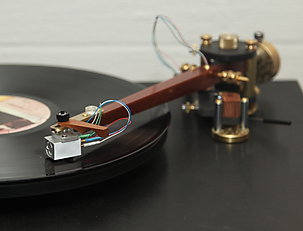 One of the things I have always admired about audiophile-land is the niche element. You know, the sort of underground, weekend warrior, I’m-smart-but-would-never-trade-my-flannel-shirt-and-slippers-for-a-lab-coat type thing. This sector of our little world has spawned multiple cool audio projects, usually done in a no-frills, classier way than any “legitimate” audio firm could ever pull off. Sure, this sector can also produce a bunch of crap with no real science to back it up and stuff that just doesn’t really work. Plus, some garage industry endeavors are fly-by-night, offering little to no buyer security. The good and the bad, the pros and the cons. My tried-and-true first generation Bottlehead Foreplay linestage was spawned by a cottage industry company and proved to be the nest egg for Bottlehead, giving it some solid footing in the industry to offer other cool, tube-based, no-frills kits for the audio experimenter. Oftentimes, guys that tinker can figure out how to make a component that not only functions better than a “real” company can, but also can design and hand-build things that are of better quality and aesthetically more pleasing. These products are typically less expensive as well, as the consumer is only paying for the product itself and not all the frills that go with keeping a company afloat. Case in point: as a kit, my Foreplay kit set me back $99 back in 1998. Not too shabby.
One of the things I have always admired about audiophile-land is the niche element. You know, the sort of underground, weekend warrior, I’m-smart-but-would-never-trade-my-flannel-shirt-and-slippers-for-a-lab-coat type thing. This sector of our little world has spawned multiple cool audio projects, usually done in a no-frills, classier way than any “legitimate” audio firm could ever pull off. Sure, this sector can also produce a bunch of crap with no real science to back it up and stuff that just doesn’t really work. Plus, some garage industry endeavors are fly-by-night, offering little to no buyer security. The good and the bad, the pros and the cons. My tried-and-true first generation Bottlehead Foreplay linestage was spawned by a cottage industry company and proved to be the nest egg for Bottlehead, giving it some solid footing in the industry to offer other cool, tube-based, no-frills kits for the audio experimenter. Oftentimes, guys that tinker can figure out how to make a component that not only functions better than a “real” company can, but also can design and hand-build things that are of better quality and aesthetically more pleasing. These products are typically less expensive as well, as the consumer is only paying for the product itself and not all the frills that go with keeping a company afloat. Case in point: as a kit, my Foreplay kit set me back $99 back in 1998. Not too shabby.
A few years back, a gentleman named Pete Riggle contacted me to see if I would be interested in reviewing an audio product that he had invented. The product is called the VTAF, which stands for Vertical Tracking Angle on the Fly. This is a modification that is designed to allow for vertical tracking angle to be set for tonearms that don’t allow for this adjustment – primarily Rega arms. As a longtime owner of a Rega RB-250, I was immediately intrigued by the offer to try Riggle’s idea. The bad thing was that I would have to permanently alter my Rega Planar 2’s plinth by enlarging the hole that accommodates the tonearm in order to install the VTAF. The above-stated apprehensions began to surface as I began to nervously think things like, “…I really hope this thing works.” Well, not only does the VTAF work, it made my analog front-end sound better, regardless of its primary goal of allowing for VTA adjustment. Plus, the product is built as solid as can be, is cleverly simple, works flawlessly, and is reasonably priced at $150. The VTAF came with complete and thorough instructions and any snags I met along the way were quickly detangled by Riggle himself within hours of me e-mailing him. I have, without hesitation, recommended the thing to anyone and everyone that I know who owns a Rega tonearm.
This same Riggle character contacted me about a year ago to inform me of a new component he was working on, and wanted to know if I would be interested in reviewing it. This time around, Riggle was upping the ante with his own tonearm design. My initial response was to think him incredibly ambitious. I mean, designing an item that enhances a primary component’s function is one thing (albeit something I could never do), but designing and building a legitimate component, and one as tricky and finicky as a tonearm, is a whole new proposal. But hey, my interactions with Riggle led me to believe that he is a no-nonsense guy with oodles of higher IQ points than poor shmucks like myself were granted. I really have no reason not to think this guy could pull it off. Plus, I am so impressed with his VTAF design, I really had no reason to say no. So, I said yes.
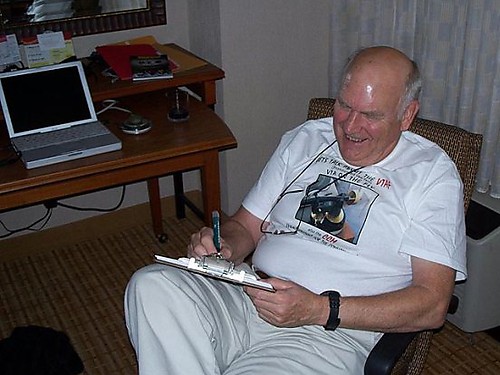
Pete Riggle
The product in question here is called the Stringtheory “Woody” Tonearm. Upon receiving it in the mail, I unpacked it and oohed and ahhed at its wood and brass beauty. Riggle says the things are a labor-intensive device to make. Each one is handmade for the customer and is made specifically for his or her cartridge to accommodate its specific requirements. How cool is that? No white-lab-coat firm currently making tonearms can offer this feature. I’ll admit, I was especially intrigued by this, as I own a Denon/Zu DL-103 that is an especially heavy fighter weighing in at over 13 grams. It sounds wonderful but is not an ideal match for my Rega RB-250 tonearm. Also, Riggle will make any length arm from 9 to 16 inches.
The other main attraction point of the Woody is that, aside from operating on Riggle’s already tried-and-true VTAF platform, it also offers his own AZOF (Azimuth On the Fly). Yes-sir-ree, you can dial in the azimuth as the record plays via the Woody. I’ll get to that later, but it is a clever, well executed design.
The Woody is a gorgeous instrument to gaze at. As the name suggests, the Woody utilizes wood as the material for the arm. Riggle has been experimenting with other types of wood, but the majority of what he has been using has been mahogany that has apparently been salvaged from a 100+ year old rocking cradle. Riggle claims that, compared to most other woods, mahogany has a “more muted resonance to taps on a plank.” Riggle went on to say that for high-compliance cartridges, he plans to use a lower density wood like western red cedar.
So the “Woody” reference and its intentional humor is obvious, but what’s with the “Stringtheory?” The Woody uses a “….uniquely configured string uni-pivot bearing” that is “stiff horizontally and vertically.” According to Riggle, the “Stringtheory” sidesteps any issues caused from bearing chatter. Basically, the pivot point of the Woody rotates on a taut, tensioned small piece of Kevlar string. Seems like a simple, obvious yet clever way to make a tonearm operate more quietly. Apparently, there are a couple of other tonearm designs based on the same idea, but the concept is new to me.
The Woody comes with a simple but incredibly well-written and informative owner’s manual that leaves few, if any, questions regarding the tonearm unanswered. Why the majority of audiophile “firms” insist on offering manuals that fall short in almost every regard baffles me. Riggle did an excellent job offering up information on all aspects of his tonearm design and installation. In my owner’s manual, it gives all the specific parameters of the tonearm – which is important seeing as how it was designed to be used with my cartridge. Riggle even supplies an alignment gauge and an overhang gauge specific to each individual tonearm.
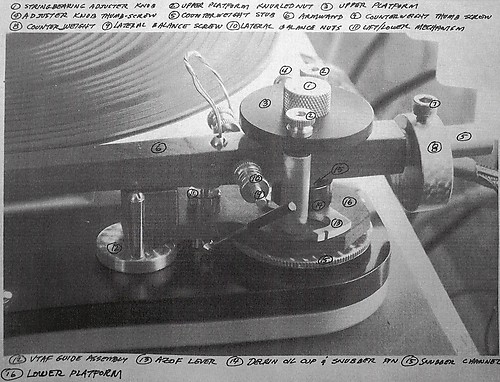
Woody Tonearm diagram from manual
So, after admiring all the wood and brass bits that make up the Woody, and reading through the owner’s manual, I got to the intimidating process of installing the thing. As I said, you have to first install the VTAF, which I had already done. Having that experience under my belt, I can now say that that is the most laborious and time-consuming process of the whole installation. Once the VTAF mechanism is in place (which entails enlarging the hole in the plinth that supports the tonearm), installing the Woody is really a snap – and dare I say, I almost enjoyed it. I could double the length of this review by getting into the details of installation of the VTAF and tonearm but I’m not going to do that. Riggle states in the owner’s manual that ease of installation and use were a primary design goal. Basically, once the VTAF is installed, like any other tonearm that the VTAF would be used for, all the user needs to do is simply slide the Woody’s shaft into the VTAF. Once there, you can install the cartridge and begin dialing in the various parameters for optimal playback. For further detailed explanation, complete with photos, refer to Riggle’s website at www.vtaf.com.
The tonearm supplied to me is 240 mm (9.45”) long and has an effective mass of 26.36 grams. The Woody uses a “continuous 6-foot run of Teflon insulated 32 gauge silver-plated stranded copper wire between the cartridge and phono stage.” Rewiring, according to Riggle, will most likely never be required, but the arm was designed to easily be re-wired should the owner decide to. Riggle gives the owner the option of utilizing oil damping with the tonearm. Not using the oil, according to Riggle, offers a more crisp and dynamic presentation. Adding the supplied oil makes the presentation more relaxed. Based on these observations, I did not add the oil.
Once you get the VTAF installed, then the tonearm resting comfortably in it with the counterweight attached, setting up the cartridge becomes the next task at hand. Like most things with the Woody, this was easier than usual. First, the Woody has a removable headshell that attaches to the arm via a single screw. Setting up a cartridge will always be sketchy business, but doing so on the Woody was by far the easiest I have ever endured. The ease factor extended to further dialing in of cartridge alignment. As stated before, Riggle provides an alignment gauge and overhang gauge (crude, but precise and effective) with each tonearm. I used my DB Systems alignment protractor to further dial in and double-check alignment as well.
Further set-up is idiot-proof with the following exception: setting the anti-skate was a bit sketchy and confusing. I have included an image from the owner’s manual showing how this is done. With some experimentation and practice, I think I got the setting dialed in but it was really difficult, and perhaps even impossible to accurately get the measurements needed to ensure proper setting. I don’t necessarily have qualms with the science behind it – I just found it hard to get the tonearm to sit still while not accidentally damaging the stylus while simultaneously trying to get the measurements between the two runs of string.
(Pete has devised a new tool that he says will make setting the anti-skate parameter much easier. As of this writing, I have not received it, but will comment on its use in part two of this review. – TA)
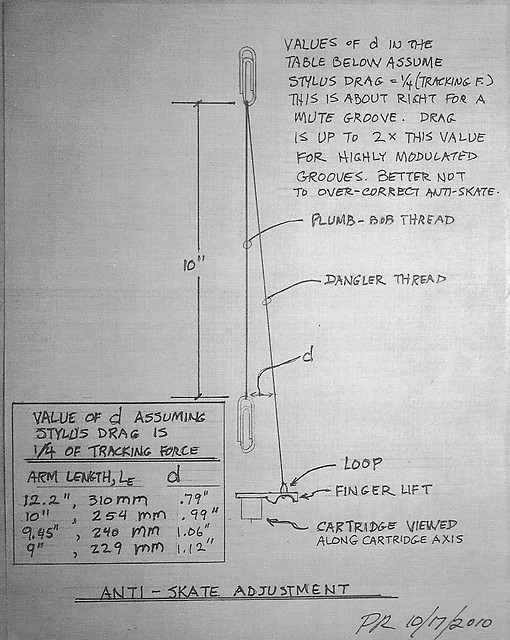
Anti-skate tool - from Woody tonearm manual
The other parameter I found a bit tricky was getting the lateral balance dialed. The Woody has two ways of setting the lateral balance. It has a screw that is placed horizontally through the wood arm towards the back, near the pivot point of the arm. On either side of it are nuts that can be adjusted from side-to-side to balance the arm laterally. Also, the counterweight can be rotated to further achieve balance and this was the method Riggle seemed to think the easiest and most effective – though I disagree. The CCM (Counterweight for the Common Man) slides on a shaft and is held in place via a screw. I found it nearly impossible to rotate the counterweight to achieve lateral balance without completely throwing off the tracking force and then vice versa. After giving this a try, I went back to just getting the lateral balance set via the screw and nuts. This process, as far as I’m concerned, was easier and more effective. Achieving balance for the Woody is the type of thing that has no measurements to guide you but rather requires the user to “get the hang of it.” In the end, like the anti-skate settings, there is a small leap of faith required in order to believe that you have gotten it right. Like all things in analogue set-up, you have to rely on your ears at some point to check your work.
On the flipside (pun intended), setting the VTA and azimuth are a snap – and so much so that you want to adjust them just for the fun of it because you can, even while a record is playing. VTA is adjusted by rotating a brass disc that sits at the base of the tonearm and hovers a mere millimeters above the plinth of the turntable. Spinning it clockwise ever so gradually raises the tonearm and counterclockwise lowers it. There is a bit of resistance and everything is in close proximity making for tight quarters, but as long as you pay attention to what you are doing, there is no problem.
The “lower platform” sits just above the VTAF wheel and just above that is the AZOF lever. Move it clockwise and the azimuth is adjusted to the right and vice versa. It’s a clever and effective design that works flawlessly.
I have never written a formal review of a tonearm before and am becoming aware at the amount of words one can spew in the process – and I haven’t even gotten to talking about how the thing sounds. Before I do, I’ll say this: I think it’s safe to say that of all the set-up processes and rituals we audiophiles conduct, tonearms and cartridges offer the most intimidating, stressful and frustrating experiences. For being a rather sophisticated design, the Woody was a snap to set-up and the whole process (alignment included) took me a little over an hour. Again, I already had the VTAF installed (which makes a big difference in terms of time) and I made periodic minor tweaks as I listened to music. Still, Riggle is to be applauded for the thought that he put into the arm’s design – not to mention its stunning aesthetics. Though, in the world of high-end audio, none of this means much if the pretty product that is easy to set-up doesn’t sound good. Stay tuned for the second part of this article!
Review System
- Rega Planar 2 turntable w/ updated/upgraded motor
- Rega RB-250 tone arm re-wired with Incognito cable
- Pete Riggle VTAF and CCM
- Zu/Denon DL-103 cartridge
- NAD PP-2 phono stage
- Sony PS1 CD player with PS Audio xStream Power Punch 7 power cord
- Bottlehead Foreplay line stage
- MC CVT2030, Royal Devices Sara 300B amplifiers
- Zu Soul Superfly loudspeaker
- Audience Au 24 speaker cables and interconnects
- Gingko Audio Cloud 14 and Mini Clouds vibration control
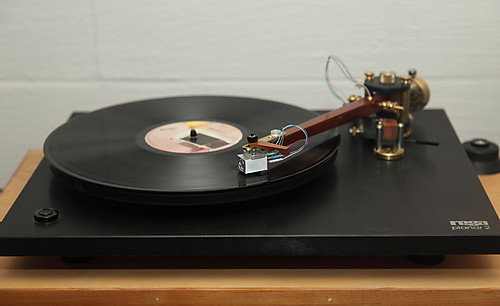
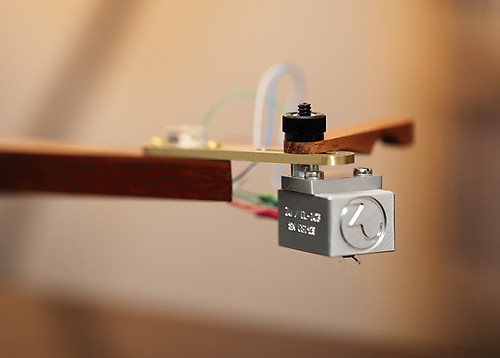
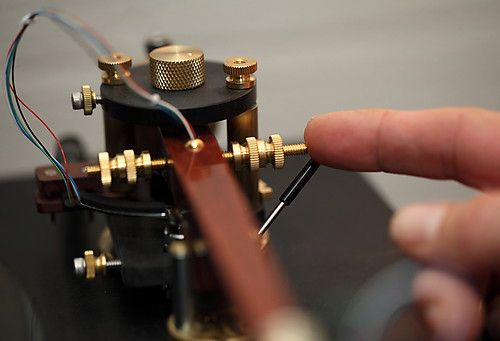
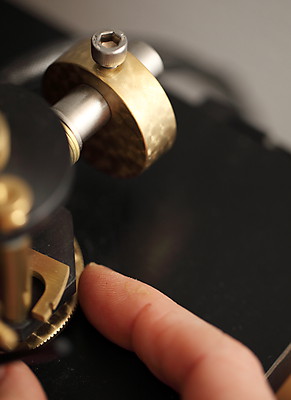




Thank youThad for a really nice piece of review work. Part 1 is an excellent summary of the mechanical details of the Woody(tm) tonearm. I really appreciate that you “get” that the arm is intended to be straightforward to adjust and use, and that you enjoy the physical beauty of the thing. Sometimes when I look at these arms I find myself thinking “Wow . . . pretty . . . where did these things come from.” Also, when you get a chance to use the Pete Riggle Azimuth Adjustment System, complete with the frame which supports It, I think you will find it relatively easy to use, and will find anti-skate to be a snap to set up. This system is soundly based on the physics of the anti-skate situation, and will be found useful to check out the anti-skate characteristics of any tonearm. I will probably at some point offer these systems as a separate product for those who wonder what their anti-skate system is actually doing. I regret that I did not get the system fully developed in time for your review. But, that said, I am completely satisfied with the review. Nice images, too. Pete